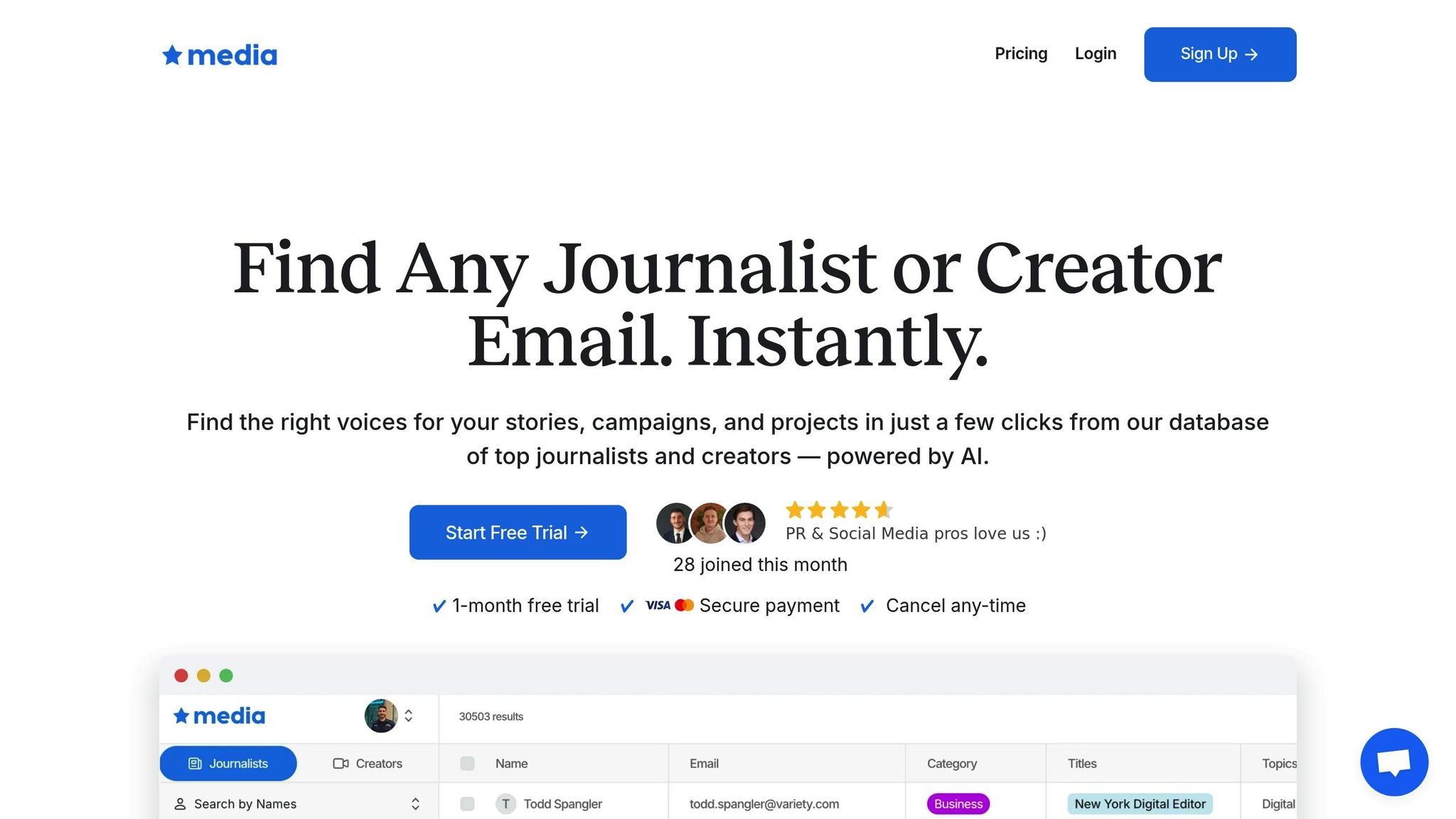How Predictive Analytics Improves Journalist Targeting
Explore how predictive analytics enhances journalist targeting in PR, boosting engagement through data-driven strategies and personalized outreach.

Predictive analytics makes PR outreach smarter by using data to identify which journalists are most likely to engage with specific stories. Instead of relying on outdated methods like generic pitches or static media lists, it leverages historical data - like coverage history, engagement trends, and timing preferences - to deliver more precise, timely, and personalized outreach. This approach saves time, increases response rates, and builds stronger media relationships.
Key Takeaways:
- Targeting the Right Journalists: Tools analyze journalist behavior (e.g., past coverage and interests) to predict engagement.
- Better Timing: Predictive models identify the best time to send pitches based on trends and journalist activity.
- Improved Efficiency: Focus on high-probability opportunities, reducing wasted outreach.
For example, personalized pitches see a 25% higher response rate, and AI-driven timing strategies can boost engagement by up to 25%. Tools like Media AI streamline this process with features like real-time updates, segmentation, and integration with CRM systems.
Predictive analytics is reshaping PR by transforming guesswork into measurable, data-driven strategies that deliver better results.
Association Insights: 5 Ways to Use AI in Your PR Efforts
Key Benefits of Predictive Analytics for Journalist Targeting
Shifting from traditional PR approaches to predictive analytics brings noticeable improvements that PR teams can measure and refine over time. These advancements translate into actionable strategies that teams can adopt to make the most of predictive tools.
Better Precision in Targeting
Predictive analytics transforms how PR professionals identify the right journalists for their stories. Instead of relying on outdated media lists or broad categories, these tools analyze individual journalist behavior to predict the likelihood of coverage with impressive accuracy.
Personalized pitches see a 25% higher response rate compared to generic ones. This success comes from matching stories with journalists based on their coverage history, engagement habits, and specific interests - not just their general beat assignments.
According to Interdependence.com, "AI-powered software can recognize that a journalist frequently writes about a certain topic and suggest customized pitch angles that align with their beat - rather than sending them a generic trend pitch."
For example, a consumer electronics brand used LSTM models to study journalist engagement patterns. By timing product announcements to align with peak journalist activity, they achieved a 25% boost in click-through rates.
Better Timing and Messaging
Once the right journalists are identified, timing and messaging play a vital role in ensuring pitches gain traction. In PR, timing can mean the difference between getting noticed or being buried in an inbox. Predictive analytics eliminates the guesswork by determining when journalists are most likely to engage and identifying trending topics.
Interdependence.com highlights that AI-driven timing strategies can boost engagement by up to 25%, ensuring pitches land at the perfect moment. These models analyze factors like news cycles, journalist schedules, and audience behavior to pinpoint optimal timing.
A financial services firm demonstrated this by tailoring content to match sentiment trends and predicted preferences. This approach led to a 20% increase in social engagement.
Less Wasted Outreach
Beyond improving precision and timing, predictive analytics streamlines outreach efforts. Traditional "spray-and-pray" methods often result in irrelevant pitches, wasting time and potentially harming relationships. Predictive tools, however, focus resources on high-probability opportunities.
Here’s a snapshot of the efficiency gains:
| Strategy | Outcome | Metric |
|---|---|---|
| Predictive Timing Optimization | 15-30% uplift in open and click-through rates | CTR and open rate (%) |
| Content Personalization | 10-25% improvement in conversion rates | Conversion rate (%) |
| Sentiment & Trend Prediction | 15-20% higher social engagement | Social engagement metrics |
A financial PR team showcased this efficiency by using natural language processing to monitor regulatory sentiment. By adapting their messaging during sensitive periods, they achieved a 20% increase in social media engagement.
Kelly Moser, Co-founder and Editor at Home & Jet, explains, "Send the right pitch to the right person at the right time, and you're no longer just another email in their overflowing inbox. You're exactly what they're looking for. And you're on your way to improving key metrics like conversion rates and social shares."
Focusing on targeted outreach not only saves time but also builds stronger relationships with journalists. When reporters consistently receive relevant, timely pitches, they’re more likely to engage in the future. This creates a feedback loop where predictive models become even more accurate, further enhancing PR efforts.
These tangible results highlight how predictive analytics is reshaping PR, making it more efficient, effective, and relationship-driven.
Steps to Implement Predictive Analytics for Journalist Targeting
Transitioning from traditional PR methods to predictive analytics requires a well-structured plan that builds on a strong foundation of data. This process involves three key phases, each contributing to a smarter and more efficient system for journalist outreach.
Data Collection and Integration
Start by gathering detailed journalist profiles that include contact information, beat assignments, coverage history, and engagement metrics - essential inputs for predictive models.
Platforms like Media AI simplify this process by providing access to a database of over 30,000 journalists and creators, complete with detailed profiles. These profiles combine contact information, beat coverage, and historical engagement data, pulling insights from sources like social media activity, published articles, and response behaviors.
For effective data collection, focus on gathering both basic and advanced insights. While contact details and beat assignments form the foundation, deeper metrics like topic preferences, email open rates, response times, and social media interactions create a fuller picture of each journalist's behavior. Capturing response patterns and timing preferences can also significantly enhance predictive modeling accuracy.
One challenge to anticipate is integrating data from multiple systems. PR teams often rely on tools like CRM systems, media monitoring platforms, and social media dashboards, which may not naturally sync. Standardizing data formats is crucial to creating unified journalist profiles that combine all relevant information - contact details, coverage history, and behavioral data - into a single, cohesive record.
Once the data is integrated, teams can move on to training predictive models to forecast journalist behavior.
Training Predictive Models
With the data in place, the next step is to develop predictive models that can estimate the likelihood of journalist interest and response. These models rely on historical data and ongoing validation to ensure accuracy.
Start by analyzing past outreach efforts. Review six to twelve months of data to identify patterns that connect successful pitches with specific journalist characteristics. Look for trends such as which story types gained traction, the timing of successful outreach, and the messaging styles that resonated most.
Feature engineering plays a critical role here. Effective models take into account multiple variables at once - beat coverage, recent article topics, social media activity, response history, and even external factors like news cycles or industry trends. Advanced models may also use natural language processing to analyze the tone and topics of a journalist's recent work, helping predict what might catch their attention now.
Before deploying the model, validate it by dividing historical data into training and testing sets. This approach helps measure how well the model predicts outcomes based on known data. Models that consistently deliver accurate predictions can significantly improve targeting strategies compared to traditional methods.
Keep in mind that model training is an ongoing process. As new data from campaigns is collected, models should be updated to refine their predictions and adapt to changes in journalist preferences and media trends.
With a trained and validated model, teams can then focus on optimizing their outreach strategies.
Improving Media Outreach Strategies
The final step is to apply predictive insights to enhance outreach strategies, moving beyond static media lists to dynamic, data-driven targeting.
Predictive analytics allows for more refined segmentation. Instead of grouping journalists solely by beat or publication, teams can create segments based on factors like likelihood of coverage, preferred outreach timing, and messaging styles. For example, if the model suggests that environmental journalists are more receptive to sustainability stories in early April due to Earth Day planning, PR teams can adjust their campaign schedules accordingly.
Real-time data processing further improves campaign optimization. Predictive models can continuously analyze new data, enabling PR teams to make on-the-fly adjustments to their strategies. This replaces static outreach calendars with flexible, responsive scheduling.
Personalization also becomes more precise. Predictive models can recommend not only which journalists to target but also how to tailor pitches for maximum impact. For instance, a healthcare journalist focused on patient advocacy might receive a pitch emphasizing community stories, while another covering medical technology might get a pitch highlighting product innovation - even if both are part of the same campaign.
Performance tracking gains new depth with predictive analytics. Beyond traditional metrics like open and response rates, teams can now monitor prediction accuracy, model confidence levels, and optimization suggestions. These insights help identify when the model is performing well and when adjustments are needed.
Media AI: A Solution for Predictive Journalist Targeting

Media AI streamlines predictive journalist targeting, offering quick and efficient solutions for PR professionals, agencies, and startups.
Overview of Media AI's Features
Media AI is designed to address the growing need for detailed data and precise segmentation. With a database of over 30,000 journalists and creators, the platform combines AI technology with predictive targeting capabilities, going far beyond traditional contact directories. Its rich datasets provide the foundation predictive models need to succeed.
The platform’s AI-powered search and filtering system allows users to segment journalists using multiple variables at once. Instead of filtering by beat alone, users can refine their search based on publication type, social media engagement, recent article topics, and even response patterns. This multi-layered approach is similar to how predictive models analyze numerous variables to deliver accurate insights.
For instance, a healthcare PR campaign could target environmental health reporters who have recently covered sustainability topics and show high engagement on LinkedIn. These tailored segments are the cornerstone of effective predictive targeting strategies.
Media AI also simplifies workflows by offering seamless export functionality. Users can transfer contact details, journalist profiles, and engagement metrics directly into CRM systems, email platforms, or analytics tools. This eliminates the need for manual data entry, which often slows down predictive analytics processes.
Real-time updates to the database ensure that users always work with current information. Stale contact details or outdated journalist preferences can undermine even the best predictive models, making Media AI’s commitment to up-to-date data a critical advantage.
How Media AI Supports Predictive Analytics
Media AI’s streamlined data collection and integration processes directly enhance predictive analytics workflows. Its design aligns with the typical three-phase implementation process, making it easier for teams to transition from traditional PR methods to predictive strategies.
During the data collection phase, Media AI eliminates the need to manually gather journalist information from various sources. Instead, it provides structured data - such as contact details, beat assignments, publication history, and social media activity - that is formatted for seamless integration into predictive models.
The platform’s detailed journalist profiles also offer valuable behavioral insights. Information about response patterns, preferred communication channels, and topic interests gives predictive models the depth they need to forecast journalist engagement accurately. For example, in 2021, The New York Times used predictive analytics to understand which topics resonated most with readers, helping their marketing team promote the right articles on social media and boost subscription rates.
Media AI’s pattern recognition capabilities uncover trends that might be missed through manual analysis. By identifying connections between journalist characteristics and successful outreach outcomes, the platform helps train more accurate predictive models.
Real-time updates ensure that predictive models stay aligned with changing journalist trends. As new campaign data is added, teams can continuously refine their strategies, improving accuracy over time. The platform also supports dynamic segmentation, enabling PR teams to adjust journalist groups based on real-time insights rather than relying on static categories. This adaptability is key for predictive analytics, where strategies must evolve based on model recommendations and performance data.
Pricing and Access
Media AI’s pricing structure makes advanced predictive analytics accessible to organizations of all sizes, removing the financial barriers that have traditionally limited such tools to large enterprises.
- Journalist Database Plan: $99/month for full access to journalist contacts and advanced filtering tools.
- Creators Database Plan: $99/month for identical features focused on creator contacts.
- Full Database Plan: $149/month, combining journalist and creator databases for integrated campaigns across traditional media and digital influencers.
This flexible pricing allows startups, small agencies, and freelance PR professionals to explore predictive strategies without committing to long-term contracts. The month-to-month model is particularly useful during the model training phase, where rapid iteration is crucial.
Additionally, Media AI’s user-friendly interface reduces the learning curve, letting teams concentrate on strategy and results rather than technical setup. This accessibility ensures that predictive journalist targeting is within reach for a wide range of organizations, from freelancers to growing agencies.
Best Practices and Ethical Considerations
To make the most of predictive analytics in journalist targeting, it’s crucial to prioritize data quality, ethical practices, and ongoing performance evaluation. These tools can significantly enhance outreach efforts, but they also come with responsibilities. Questions around data privacy, fairness in algorithms, and professional ethics need to be addressed thoughtfully by PR teams.
Regular Updates to Journalist Databases
Keeping journalist databases current is essential for accurate predictions. Regularly verify contact details, beat assignments, and career changes. While automated tools like Media AI can update data in real time, teams must still cross-check model predictions against recent campaign outcomes and maintain thorough documentation of data sources and update schedules.
Predictive models also need frequent retraining to stay relevant. Media landscapes shift constantly - topics that resonated last quarter might fall flat today due to changes in social media algorithms, editorial priorities, or the emergence of new platforms.
Documentation is a cornerstone of maintaining data quality. By recording data sources, update timelines, and any known gaps, teams can better understand model outputs and identify when more data is needed. These practices ensure that predictive targeting remains both effective and responsible.
Ethical Use of Data
Predictive analytics brings up important ethical issues, especially around data privacy, algorithmic bias, and transparency, which PR teams must tackle head-on.
Start by obtaining clear consent and being transparent about how data is collected, used, and accessed. This openness builds trust without revealing proprietary algorithms. Additionally, collect only the data that’s directly relevant. For example, if a model predicts story topic preferences, there’s no valid reason to gather unrelated personal social media activity. Privacy-by-design principles should be built into systems from the outset, not added as an afterthought.
Algorithmic bias is another critical concern. If training data disproportionately represents certain publication types, regions, or demographics, the model might skew its targeting. Regular bias audits can help identify and correct these issues, ensuring more balanced outcomes.
Even with advanced predictive tools, human oversight is indispensable. Automated suggestions should complement - not replace - human judgment. PR professionals should review recommendations, question anomalies, and override the model when necessary. By following these ethical guidelines, PR teams can focus on refining their strategies while maintaining accountability.
Measuring and Improving Strategies
The best predictive analytics programs don’t stop evolving after their initial implementation. Success lies in continuous monitoring and refinement. Performance metrics should go beyond basic indicators like open rates to assess prediction accuracy and reliability.
Track how well the models predict journalist engagement, response rates, and story placement success. If certain predictions consistently miss the mark, dig into the reasons - whether it’s outdated data, model limitations, or shifts in the industry. A/B testing can help identify which approaches yield better results.
Feedback loops are key to improving accuracy over time. When journalists share input about pitch relevance or timing, incorporating that feedback into the model can sharpen future targeting. Even negative feedback is valuable, offering clues about why specific predictions failed and how to avoid similar missteps.
Post-campaign reviews are another critical step. Analyze which recommendations worked and where the model fell short. This analysis helps fine-tune tactical decisions and informs broader strategic adjustments.
Tracking prediction accuracy over time is also essential. If accuracy declines, it’s a sign the model might need retraining or restructuring to reflect the current media environment. Collaboration across teams further strengthens outcomes - account teams can provide insights into client goals, while creative teams can identify which messaging resonates with journalists. Together, this ensures that predictive analytics aligns with larger strategic objectives rather than focusing solely on technical metrics.
Conclusion: Using Predictive Analytics for Smarter Outreach
Predictive analytics takes the guesswork out of journalist outreach, transforming it into a focused and measurable strategy. By examining patterns in journalist behavior, story preferences, and engagement history, PR professionals can fine-tune their approach, making outreach more precise while cutting down on wasted time and resources.
The key benefits - better targeting, perfect timing, and personalized messaging - depend on maintaining high-quality data, using it responsibly, and continually refining strategies. The best PR teams see predictive analytics as a dynamic tool that improves with every interaction and feedback loop.
This is where Media AI steps in. With its AI-powered database of over 30,000 journalists and creators, the platform simplifies data-driven outreach. It eliminates the need to build predictive models from scratch and provides advanced filtering and export features, making targeted campaigns easier and more effective.
As the media landscape grows increasingly competitive and fragmented, adopting predictive analytics now can give PR teams a lasting edge. It’s not a question of if predictive analytics will change PR outreach - it’s about whether your team will be at the forefront of this shift or playing catch-up.
FAQs
How can predictive analytics help PR professionals connect with the right journalists for their stories?
Predictive analytics is a game-changer for PR professionals looking to connect with the right journalists. By sifting through massive datasets, it identifies trends and patterns that reveal which journalists are most likely to engage with specific topics or stories. This approach streamlines outreach efforts, making them far more targeted and effective.
Using techniques like regression analysis, machine learning, and neural networks, predictive analytics can anticipate a journalist's interest based on their past behavior and preferences. Tools like Media AI simplify this process further, offering access to a database of over 30,000 journalists and creators. These platforms help PR teams filter and connect with the right contacts, ensuring each campaign hits its intended audience.
What ethical considerations should PR teams keep in mind when using predictive analytics to target journalists?
When leveraging predictive analytics to connect with journalists, PR teams need to put data privacy at the forefront. It's crucial to handle personal information responsibly and ensure compliance with all relevant regulations. Being transparent about how data is collected and used not only builds trust but also reinforces your credibility.
Another key consideration is addressing bias within predictive models. If the data feeding these models is skewed, it can result in unfair targeting or the exclusion of certain individuals. By aiming for fairness in outreach efforts, PR teams can uphold journalistic integrity and create stronger, more respectful relationships with media professionals. Staying accountable throughout the process is essential to ensure ethical practices and to avoid the pitfalls of spreading misinformation or engaging in manipulative tactics.
How can PR teams keep their predictive models accurate and effective over time?
To keep predictive models accurate and relevant, PR teams need to consistently monitor their performance and make updates when necessary. This means keeping an eye out for shifts in data patterns - commonly referred to as data drift or concept drift - and recalibrating or retraining the models to ensure they remain in sync with current trends.
Bringing in new, high-quality data and tweaking models to reflect changing market conditions and audience behavior is equally important. These steps help ensure that outreach strategies stay effective and continue driving impactful results.





